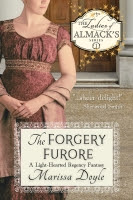 This parasol is not Victorian--I'm guessing it's early twentieth century--but the tassel and beautiful repousse silver handle ( I wish it showed up better in the photo) are a definite reminder of earlier days.
This parasol is not Victorian--I'm guessing it's early twentieth century--but the tassel and beautiful repousse silver handle ( I wish it showed up better in the photo) are a definite reminder of earlier days.The ideal of feminine beauty up until the early twentieth century was a fair, white complexion. To some degree, this probably had its origins in economics: if you were pale and soft-skinned, it meant you didn't spend your time out of doors working in the fields or taking care of farm animals...which meant your family could afford to have other people do that work for you.
 Of course, that didn't mean you never stirred out-of-doors...but it did mean that when you did go out for a stroll around the garden or a gentle trot down the Ladies' Mile in Hyde Park, or for a visit to the seashore, you used a parasol, wore a hat (and often a veil swathed over your face) and wore gloves to keep the skin of your hands equally white. Like this young lady of 1815, attired for walking.
Of course, that didn't mean you never stirred out-of-doors...but it did mean that when you did go out for a stroll around the garden or a gentle trot down the Ladies' Mile in Hyde Park, or for a visit to the seashore, you used a parasol, wore a hat (and often a veil swathed over your face) and wore gloves to keep the skin of your hands equally white. Like this young lady of 1815, attired for walking.And if (oh, horrors!) you were negligent and let your parasol drag behind or used it to keep obnoxious suitors at bay, then you rushed home to apply one of the dozens of commercially prepared lotions, like "Godfrey's Extract of Elder Flowers...To be had of any respectable Perfumer or Medicine Vendor in Bottles at 2s. 9d. each" which promised to "...communicate a refreshing coolness and softness to the skin, and completely remove Tan, Pimples, and cutaneous Eruptions...."
By the late nineteenth/early twentieth century, this attitude had changed. As more young women of the lower economic classes took jobs in factories and shops and offices, having a tan (a light one, mind you--just a glow) implied that you had the leisure time to engage in healthy outdoor pursuits like tennis or golf or riding and weren't stuck indoors all day, working for a living...in other words, a completely opposite attitude!
 And one final word for today: don't try to take pictures on the floor when there's a nosy rabbit around. I wonder if the orange fabric gave him hopes of a giant carrot?
And one final word for today: don't try to take pictures on the floor when there's a nosy rabbit around. I wonder if the orange fabric gave him hopes of a giant carrot?





No comments:
Post a Comment